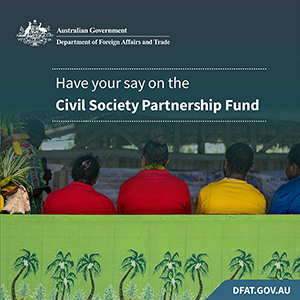The Australian Government has committed to the design and delivery of a new Civil Society Partnerships Fund (CSPF) to address the challenges of shrinking civic space in the Indo-Pacific region.
Australia recognises the value of building genuine partnerships with civil society organisations and others to improve access to civic space. Civic space allows for people to meet, express themselves, share information and contribute to decisions that affect their lives. A robust civic space is important in all open and democratic countries and is one of the key building blocks for a stable region.
The Foreign Minister, Senator the Hon Penny Wong, said at the launch of Australia's International Development Policy
"Australia is…working with the region to strengthen its resilience and to help deliver its aspirations."
The Australian Government wants to ensure support goes beyond civil society organisations, to protecting civic space for people to actively engage in public life.
DFAT is grateful for input already provided by stakeholders, including civil society organisations, think tanks, and peak bodies. This input has helped shape and refine possible approaches, as outlined below. DFAT is now inviting written submissions to inform the priorities and the approach to designing the new CSPF.
What we have heard
We have heard from a range of stakeholders during our early design process as we work to establish the CSPF. This includes targeted consultations, as well as broader consultations associated with the creation of Development Partnership Plans (DPPs) and global thematic strategies.
Some stakeholders have proposed the establishment of a new – or support to an existing – platform to act as a focal point for Australia's international engagement in civic space. We have heard of the benefits of working as directly as possible with civic actors, minimising reliance on intermediaries1.
We have heard proposals for supporting and engaging active and credible Australian community groups who are already working to support civic space in Australia, and with their partners across the region, particularly with groups not traditionally involved in international development. This focus on engaging Australian civil society could "draw upon strong existing partnerships with respected institutions that are deeply embedded in local communities"2, as well as supporting new partnerships that might not otherwise be formed.
We have heard suggestions to create a dedicated grants program or similar mechanism, potentially operating at arms-length from Government, to support those working to defend and expand civic space, while also moving beyond supporting individual organisations and towards the enabling environment for effective civic engagement.
We have heard of the importance of local context, and how an approach to supporting civil society and civic space should recognise the distinct nature of civil society across the region.
We have examined existing activities. Australia will continue to support civil society organisations directly through our bilateral programs, guided by DPPs, as well as global programs such as the Australian NGO Cooperation Program (ANCP). We have heard that any new activities should work alongside these existing efforts, with a focus on supporting the enabling environment.
Guiding topics and questions
Based on consultations and input received, we now welcome written submissions answering one or more of the following questions to help guide further formal design processes:
Our objective is to support and expand civic space across the Indo-Pacific.
- Based on this objective, what benefits can Australia bring to supporting and expanding civic space that takes an Australian perspective and is appropriate to diverse contexts and cultures?
- What are the emerging and innovative approaches for impactful engagement in civic space that should be reflected in the design (e.g. digital, grassroots and non-traditional forums)?
- Are there particular experiences that may provide lessons from others that we should consider as we progress the design?
We want to connect and engage Australian organisations working to support and expand civic space.
- We have heard that the CSPF can play the role of facilitator, convener, direct funder, and knowledge sharer. How should the design consider the balance of these approaches?
- Some have called for "arms-length" arrangements from Government in supporting and expanding civic space. Is this achievable, and are there good examples of this in practice?
We want to plan for and measure success.
- What best practice and innovative examples should be considered for capturing impact and performance?
- How can we embed efforts to "do-no-harm"?
- How can we ensure sustainability over time?
Consultations and engagement undertaken to date will continue to be used in the design, and submissions can reference such prior input rather than restating.
Submissions should be no more than 1,000 words and should be provided by no later than 5pm AEST, 22 August 2025 to CSPF@dfat.gov.au

